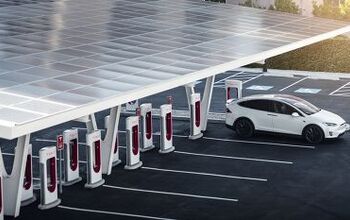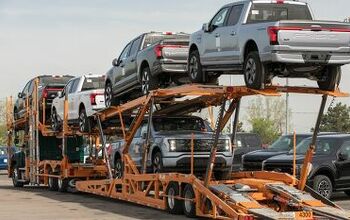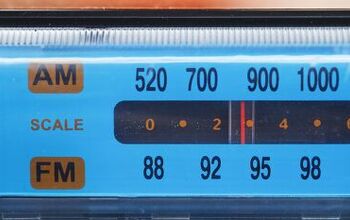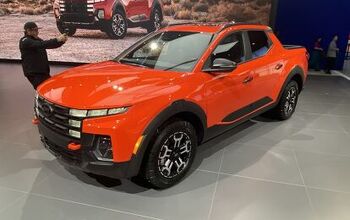General Motors Death Watch 145: The Truth About GM's August Sales
Imagine GM CEO Rick Wagoner in his RenCen bunker in the middle of August. Reports from the front indicate his North American division faces a third straight month of lowered sales. As the architect of a turnaround plan with no publicly defined goals (including a return to profitability), Wagoner’s given himself plenty of wiggle room. But a bad August– in the face of production cutbacks and a rapidly declining market– would finally trigger Wall Street’s alarm clock. So what does he do? He cheats.
In August, GM’s year-on-year sales rose by 6.1 percent. In the same period, Toyota’s sales declined by 2.8 percent. On the face of it, it’s a stunning result. The media and Wall Street’s reaction was both swift and positive. “Investors given hope after GM bucks downtrend” MSNBC proclaimed. On Tuesday, GM shares rose by $1.18 (3.8 percent). Clearly, Wagoner's wily ways worked: he dodged the bullet.
Despite the obvious anomaly, industry experts weren’t all that interested in examining the figures for a suitable explanation. IRN Inc. auto analyst Erich Merkle spoke for many when he told Bloomberg “It was a quirky month.” Quirky or not, all GM's upward movement came from light truck sales, which rose by 16.5 percent. (Passenger cars sales tanked by a Toyota-beating 7.8 percent.) So the press credited the jump to a sudden increase in consumer demand for GM's pickups and called it good. Very good.
And yet, the clues to the real state of affairs were there for all to see, right in GM’s press release. “When combining retail sales with our growing commercial business, our sales were up when compared with last August,” Marketing Maven Mark LaNeve crowed. "With the double-digit decline in daily rental sales so far this year, and an overall market that remains challenging and competitive, we continue to stabilize our retail share and pricing in the market.”
Growing commercial business? Is this the same GM that said it loud and said it proud: we hereby swear-off fleet sales to protect retail residuals and get GM out of the “pile ‘em high and sell ‘em cheap” mentality? The numbers tell the tale. In August, GM’s total fleet sales rose by 21 percent. And as for LaNeve’s professed “double digit decline in daily rental sales,” note the “so far this year” qualifier. GM’s sales to rental companies increased by 24 percent during August.
In other words, Wagoner’s mob reneged on their promise to their retail customers. They sacrificed their retail customer's vehicular equity to goose the company's August numbers. They cheated. Sometime in mid-August, someone placed a call to fleet buyers and said OK, we’re done starving you of cheap cars. How many would you like ‘cause we got LOTS.
It’s hard to be specific. In a radical and deeply suspicious break with previous policy, GM didn’t separate out fleet and retail sales numbers for August. But the fact that sales of all the usual rental car suspects (Pontiac G6, Chevrolet Impala, Chevrolet Malibu, etc.) matched or exceeded last year’s totals in a declining market is pretty damn damning. If you think about it, that 7.8 percent drop in GM's car sales would have been catastrophic without bulk sales.
As for the trucks, again, we have no idea how many went to fleets. But you can bet it was a bunch. Whenever there’s a statistical anomaly–such as the reversal of GM’s sales losses and Toyota’s sales gains– common sense says something’s changed. On the retail truck side, there’s only one factor that could explain a Silverado or Sierra surge: increased incentives. From July 31 onwards, GM offered from $2k to $4k incentives or zero percent financing on their pickups– even as Toyota quietly dropped national incentives on their Tundra.
Sacrificing profits for sales might increase sales, but it does nothing for profits. So even if GM's 30 percent increase in pickup truck sales isn’t fleet related, the surge isn’t all that it’s cracked-up to be. Truth be told, The General’s recent pickup truck production cutbacks sent a clear signal to alert observers that the automaker's August sales increase must be a temporary bump on a rocky road to oblivion. Short term, GM’s headed straight for lower pickup truck sales AND reduced profit.
Since the numbers received so much attention, let’s finish with the numbers.
Frank Williams says GM’s August increase is based on percentage change per sales day. If you just compare the total numbers from Aug ‘07 to Aug ’06, there's only a 4.9 percent sales increase. Since both months had the same number of selling days (27), there’s only one reason to change the formula: to inflate the percentages. But no matter how they slice it, GM’s still down 7.5 percent overall year to date. While a few models may be showing some increases, the overall trend is decidedly downwards.
Mr. Wagoner can hide from the truth, but there’s nowhere left to run.
More by Robert Farago
Latest Car Reviews
Read moreLatest Product Reviews
Read moreRecent Comments
- Redapple2 I m afraid I d hate the crazy color 2 yrs down the line of a 6 year ownership. So, after dark blues, and dark reds I m back to a wonderful deep, pearly, lustrous white. Looks good at night. In the day. Clean; and when dirty, hides it.
- THX1136 Some folks down the street from me had a beautiful blue/green Jeep. I stay away from grey, brown, silver and black. Ironically I own a white vehicle at the moment due to not being able to afford the blue one I was considering and not wanting the aforementioned colors. A nice emerald green, most shades of blue (Santa Fe Blue is a favorite) and the 'hotter' colors like orange, purple and yellow appeal, but as KOKing mentioned it's got to look 'right' on the car in question.
- THX1136 It's good knowing a purchase decision was well made. Glad to hear it's been a good car for you, Corey! May the good times continue to roll.
- Kwik_Shift_Pro4X I like bright red, like Ford's "Race Red" with black accents/trim on hot hatches. A distant second would be a lighter school bus yellow, like on a 90s Land Rover Discovery Camel Trophy edition.
- KOKing The color has to look right on the car first and foremost, but given the choice, I'll pick the not-bland color every time.


































Comments
Join the conversation
+1 on buying a lightly optioned standard truck. They are the best deal and maintain their value much better than the extended / crew cab models. I recently took over a lease on a 2500HD standard cab with 8' bed. I swapped in an older cd / usb player and have a nice stereo. I also got a leased truck with no down payment, the employee pricing advantage (as the original lessee was an employee), an incentive by the lessee to take over their lease, and the security deposit at the end. I've got 2 years left and it allows me to evaluate the truck and decide whether I want to buy it at the end of the lease (or more importantly off warranty). So I suggest buying or taking over lease payments of a slightly used standard pickups if you truly need a truck. It'll save you the most down the line.